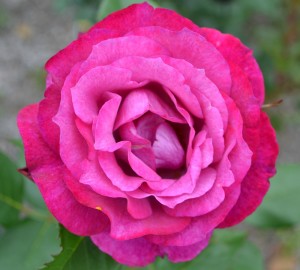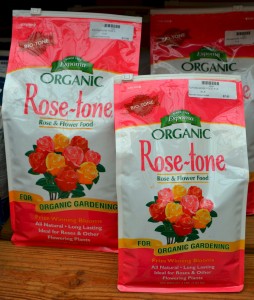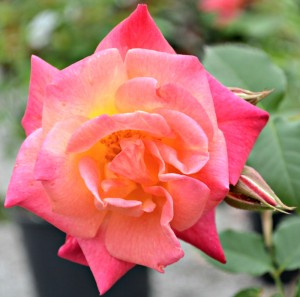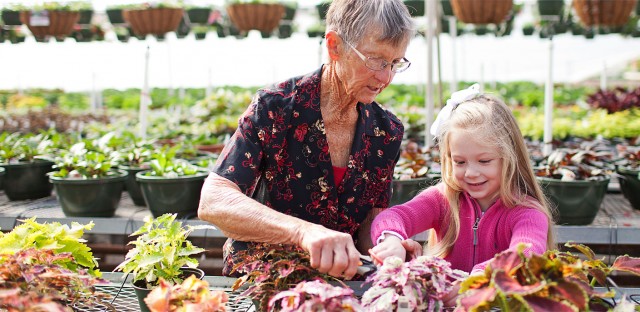How to Grow Super Roses
All Roses Can Be Super:
PRUNING

Pruning is one important thing you should do every year (climbers & certain smaller varieties might require a different technique). Roses will continue to grow taller & taller and it won’t be too many years until you have an unmanageable tangle. Rose pruning should be done while the roses are dormant, before they start to produce new growth each. That means start in late February or early March and be finished before the roses start to leaf out in warmer weather.
If you have newly purchased roses they are not taller than 20 inches do not cut them back this year. For those of you who have older plants (hybrids, floribunda & shrub) reducing their height to about 15-18 inches is your first step to growing super roses. It is good for the bush to have an open center but you don’t have to get crazy about removing other stems right away. About the 3rd year you might want to remove a few of the older canes. For hybrid tea rose growers, pruning for exhibition roses is almost an exact science with only 3-5 canes in an opened center vase pattern. If you are not interested in winning a blue ribbon at the state fair, reducing their height and removing dead, damaged, diseased & twiggy canes should be good enough.
SPRAYING
Spraying is a chore no one seems to enjoy. The amount of time spent growing super roses can be reduced if you spray them in the dead of winter. An oil spray is a non selective spray and will suffocate many insects and their eggs that can negatively effect the rose. Read the labels, some oils can be used year round and are good for fighting many insects and scale on many different plants.
Another spray that is beneficial in the winter before bud break is lime sulfur (considered a dormant spray). Be sure to spray the area around the roses too, many insects overwinter in the soil & mulch.
Super roses could use a bit of lime once a year if the soil isn’t perfect. A soil test will dictate exactly what your rose needs. In the absence of a soil test you usually can apply a ½ cup (per bush) annually to keep them happy. When planting for the first time mix 1 cup of lime per bush into the soil if the area has not been limed before.
FERTILIZER
 Roses will be healthier if they are properly fertilized. A shovel full of composted manure in early spring helps get them off to a nice start. When creating a new bed, always incorporate manure or organic matter into the soil. When you see the first bit of new growth showing on the canes it is time for the first fertilizer application. A balanced fertilizer like an 8-8-8- or 10-10-10 will do nicely. Once the roses form bud, fertilize them regularly throughout the growing season depending on your fertilizer of choice. Varieties of fertilizers available include: granular, organic, just for roses mixtures, a systemic liquid rose fertilizer with a miticide & insecticide combination, plain liquid fertilizers, time released fertilizers, or the granular fertilizer like you used at bud break.
Roses will be healthier if they are properly fertilized. A shovel full of composted manure in early spring helps get them off to a nice start. When creating a new bed, always incorporate manure or organic matter into the soil. When you see the first bit of new growth showing on the canes it is time for the first fertilizer application. A balanced fertilizer like an 8-8-8- or 10-10-10 will do nicely. Once the roses form bud, fertilize them regularly throughout the growing season depending on your fertilizer of choice. Varieties of fertilizers available include: granular, organic, just for roses mixtures, a systemic liquid rose fertilizer with a miticide & insecticide combination, plain liquid fertilizers, time released fertilizers, or the granular fertilizer like you used at bud break.
You will need to spray some rose cultivars on a regular basis to avoid or reduce damages from diseases & insects.
A word about those dreaded Japanese beetle. Yes, they eat your roses! You can use a systemic insecticde, pick them off, spray for them, plant marigolds around them or, do like I do, & remove the blooms at the first sight of a beetle (no blooms, no beetles). By the time the rose has generated the next flush of blooms the beetles have completed their life cycle and are gone.
& remove the blooms at the first sight of a beetle (no blooms, no beetles). By the time the rose has generated the next flush of blooms the beetles have completed their life cycle and are gone.
WATER
One factor you cannot neglect is moisture. Roses need water! They should receive a minimum of one (1) inch a week during the growing season. Avoid prolonged dry spells!
Good soil preparation is the next step (see Fairview’s Rose Growing Guide, it is a month to month guide to help you remember how to do what when). Rose-Care Guide (.pdf)
See you in the rose section!




